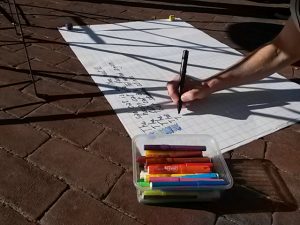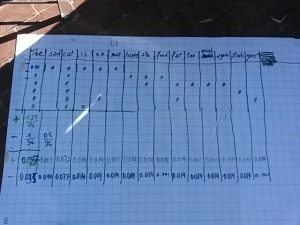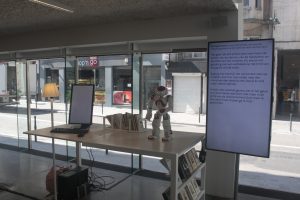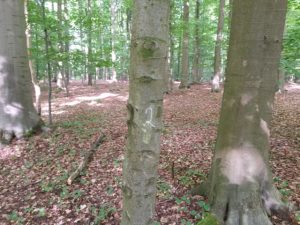In maart 2019 ontving ik een Onderzoeksgerichte Beurs van de Vlaamse Overheid. Een jaar lang kreeg ik tijd en middelen om me nog verder te verdiepen in het concept van de Algoliteraire Vertellers.
» Read the rest of this entry «Anaïs Berck
February 27th, 2020 § 0 comments § permalink
Algoliterary Game: Naive Bayes
October 17th, 2018 § 0 comments § permalink
The Algoliterator
June 1st, 2018 § 0 comments § permalink
The Algoliterator is an installation by Gijs De Heij & An Mertens, Algolit, Constant. It was shown in the framework of Public Domain Day 2018 in the public library in Muntpunt, Brussels.
Linear Regression – a forest game
January 31st, 2018 § 0 comments § permalink
The forest lends itself as a metaphor for talking about big data. We are interested in the forest because of the amount of trees there are. We enjoy their view, their rustling, the multitude of trunks, fruits, plants. Apart from the forest rangers, few visitors have knowledge of individual trees in the forest, unless they fall outside ‘normality’. Particularly old, thick, large trees, rare specimens can sometimes catch our attention. But the large part of the trees is only interesting for us as a group.
In the same way, companies look at us, users of their technology. When they make up profiles based on our clicks, likes and comments, their focus is not our individual personality, but what we have in common with others, our relationships, our existence in group(s).
Trees are also interconnected via underground networks of mycelium, a phenomenon that covers our entire globe and is referred to as ‘the woodwide web’. Therefore it is tempting to start organising small algorithmic games in the forest based on algorithms used in predictive models.
A first game is an interpretation of the ‘linear regression’. Next to finding a correlation – however subjective, statistically irresponsable and minimal the measurements may be – this exercise also shows the negotiations and compromises that you go through along the way to arrive at usable and measurable data. It is also a very nice way to look at trees in detail.
The story of two sacred trees – a modern fairy tale
March 28th, 2017 § 0 comments § permalink
This story has been written using a Python script and scraped data from the website of Jubelparkmuseum. The story, the code and all the sources are published under a Free Art License: http://artlibre.org.
The main scripts were developed in the framework of DiVersions, a residency of Constant in Musée du Cinquantenaire in December 2016. With a warm thank you to Constant & the Jubelparkmuseum for the tools and the data!
This is what I know about myself.
The description given to me is that of a sacred tree. I am included in the Near East Collection. In case you decide to dress me one day: my height is 75 cm, my width is 87 cm. I have been tagged a relief. I have been categorized with the number o.00271. My body is made of stone. My great grand parents must have lived before -883 / -859. I should be able to find some relatives in Near and Middle East (Asia) as my place of production, and in Nimrud (Asia > Mesopotamia > Assyria) as my place of discovery: . My cultural background is Assyrian. » Read the rest of this entry «
A story from the Algorithmic Forest
March 4th, 2016 § 0 comments § permalink
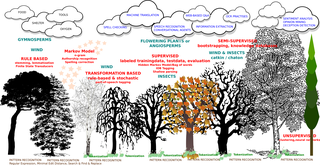
This image gives an overview of existing techniques for text analysis. By drawing them as a forest, it becomes clear how their application resembles the ecological succession of a forest. In the Brussels process of Forêt de Soignes/Zoniënwoud, the forest came to existence thanks to pioneer species after the last Ice Age. These species can survive on very harsh soil. They grow fast. As they don’t need much to live, produce and reproduce, they are very efficient fertilizers and prepare the soil for other more complex species to come. » Read the rest of this entry «
Literaire algoritmische spelen: Markov Chain
January 24th, 2016 § 0 comments § permalink
De Markov Chain werd ontworpen in 1906 door Andrey Markov, een Russische wiskundige die het leven liet in 1992.
Dit algoritme ligt aan de basis van heel wat softwares die spam genereren.
Het wordt gebruikt voor systemen die een reeks evenementen beschrijven die onderling afhankelijk van elkaar zijn. Wat gebeurt, hangt enkel af van de vorige stap. Daarom worden Markov Chains ook ‘geheugenloos’ genoemd.
Het spel werd ontwikkeld in twee versies, een versie met zinnen en een kaartsysteem (ism Brendan Howell, Catherine Lenoble en Désert Numérique); en een versie met voorwerpen (ism de deelnemers aan de workshop in december 2015 in Consonni, Bilbao: Itziar Olaizola, Emanuel Cantero, Pablo Mendez, Ariadna Chezran, Iñigo Benito, Itziar Markiegi, Josefina Rocco, Andrea Estankona, Mawa Tres (Juan Pablo Orduñez), Maria Ptqk).
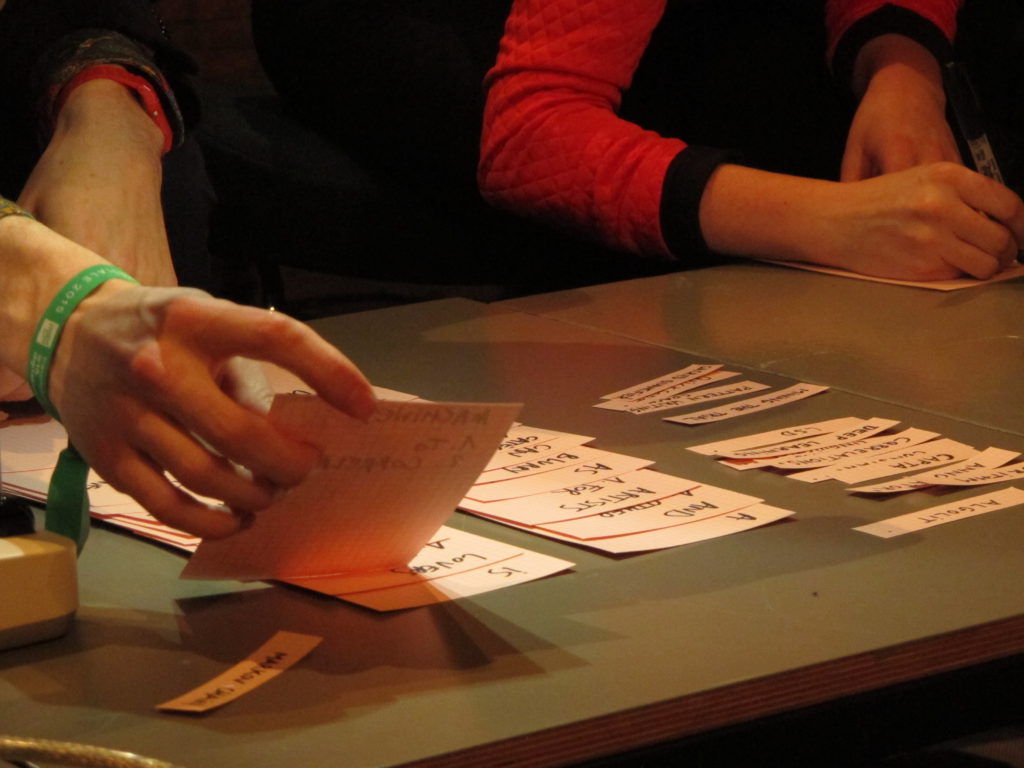
Transmediale, Berlijn, jan 2015
Algoritmische vertellers
January 4th, 2016 § 0 comments § permalink
Een jaar lang zal ik het narratieve potentieel van algoritmes onderzoeken.
In mijn aanpak wil ik ze zowel benaderen als spelleiders, schrijvers van teksten en vertellers op een scène. Tijdens een vooronderzoek testte ik al enkele formules uit met eenvoudige algoritmes zoals de Quicksort.
Voor dit onderzoek wil ik me toespitsen op zelflerende algoritmes die school maken in de verwerking van big data die we dagelijks produceren door ons gebruik van Google, Facebook, smartphones enz. Gelijkaardige computermodellen worden gebruikt voor tekstmining, het veld waartoe ik me wil beperken voor dit onderzoek.
Door de algoritmes te deconstrueren en hen vervolgens in te zetten in andere contexten dan die waarvoor ze gemaakt zijn, hoop ik hun poëtische aard te ontsluieren. Mijn focus ligt daarbij op het verhaal en het spel, en veel minder op hun technische performativeit.
Voor dit onderzoek kreeg ik de toekenning van een onderzoeksgerichte beurs van de Vlaamse Overheid.
![]()
Literaire algoritmische spelen: L’abécédaire
December 23rd, 2015 § 0 comments § permalink
L’abécédaire is a constraint by Oulipo: ‘Texte où les initiales des mots successifs suivent l’ordre alphabétique’.
The Quicksort-algorithm is very helpful to play l’abécédaire as a game.
Rules in English & French: http://www.algolit.net/images/abecedaire.pdf
More in Dutch:
L’abécédaire is een recept van Oulipo:
‘Texte où les initiales des mots successifs suivent l’ordre alphabétique’.
Het Quicksort-algoritme is een dankbaar algoritme om l’abécédaire als spel te spelen, binnen of op straat. » Read the rest of this entry «
